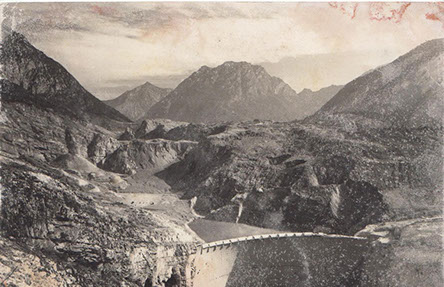Why a project on Vajont? What were the initial motivations and how did the research develop?
I have being interested in photography with events that have had a collective impact or significance, looking to them through my personal perspective.
I engage my vision with elements such landscapes or observed portraits looking for traces –better say echoes- of such facts.
One of my former project ‘My broken world’ was about the earthquake in Irpinia: after 30 years from the aftermath I went back and I looked for signs of this change. Widely I consider the earthquake of 1980 in Irpinia as a switch from a rural to a sort of postindustrial world, a phenomenon that’s been affecting also the area of Vajont. So the opportunity to research for CALAMITA/A’ project, has seemed both to the curators than me as an interesting challenge to move forward in my work.
Vajont as a historical event weighs on current reality and inevitably on its transcription, description and representation.
How much has this relationship affected the project?
I’m just about starting my project, but I believe the historical aspect will be an important pivotal in my approach. My background is in Political Studies and the tragedy of the dam was the fact which cracked the social contract in the local community and had a strong reverb in the national frame.
I’m particularly interested for this kind of rip and to use the historical background as a scaffold for constructing my narrative.
Photography can act as a tool of investigation and analysis complementing traditional practices of urban and territorial planning. What is the personal contribution of your project to the interpretation of this territory?
The disaster of Vajont crushed in few moments a story of millennium considering the landscape, but also the economical and social structures in the area. I consider photography in its fragmented essence an important tool to reflect about the idea of territory, due to its inner capacity of travelling through space and time.
Landscape doesn’t exist, but the idea of landscape that each of us have does. This creates a space for dialogue. The photographer can show through his work an interpretation of the landscape highlighting aspects of social and civil nature. Which elements and features of the landscape did you want to trace with your point of view?
I think I have being particularly influenced by the tales I heard about the moments of the tragedy, when in few minutes the landscape and everything connected to it has changed forever.
I chose the word “submerged”, and through it I took a first step in order to envision my story of Vajont: it was a first kick, I’m looking forward to seeing where it will lead me.

CALAMITA/À
THE VAJONT CATASTROPHE
The Vajont Dam is a disused dam, completed in 1959 in the valley of the Vajont River under Monte Toc, in the municipality of Erto and Casso, 100 km north of Venice, Italy. One of the tallest dams in the world, it is 262 metres high, 27 metres wide and 22.11 metres thick at the base and 191 metres wide and 3.4 metres thick at the top.
The dam was conceived in the 1920s, designed by Carlo Semenza, and eventually built between 1957 and 1960 by Società Adriatica di Elettricità (English: Adriatic Energy Corporation), the monopoly electricity supply and distribution monopoly in northeastern Italy, which was owned by Giuseppe Volpi di Misurata. In 1962 the dam was nationalized and came under the control of ENEL as part of the Italian Ministry for Public Works. It was described as ‘the tallest dam in the world’, intended to meet the growing demands of industrialization, and as of 2010 is still one of the tallest in the world. On October 9th, 1963 at 10:39pm 260 million cubic meters of rock broke off from the top of Monte Toc. It fell into the reservoir of the Vajont Dam producing an enormous wave of at least 50 million cubic meters of water. The wall of water pushed an air pocket before it.
It was more powerful than the Hiroshima bomb. So strong, in fact, that almost all the victims were found naked, their clothes blown off by the blast. The dam, completed in 1959 and the biggest in
the world at the time, did not suffer any serious damage. However, the flooding destroyed several villages in the valley and killed almost 2000 people. It was, according to the Unesco, one of the worst man-made environmental catastrophes of all time. The disaster wasn’t due to the evil nature of man but more to human negligence.
Postcard "The Vajont Dam", 1964

